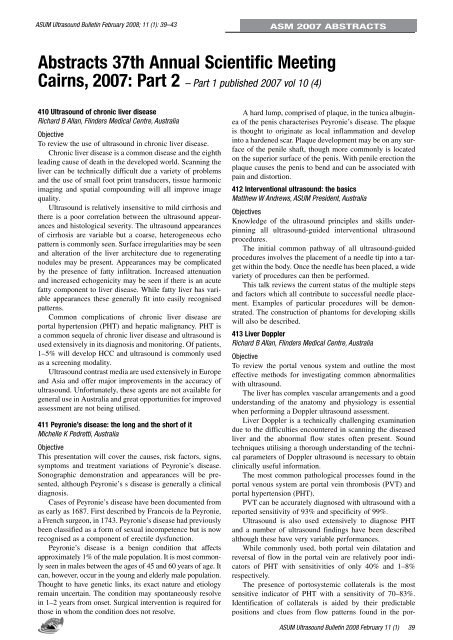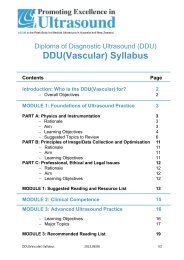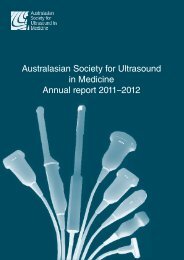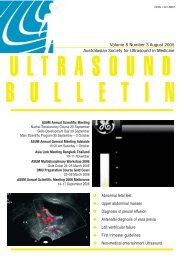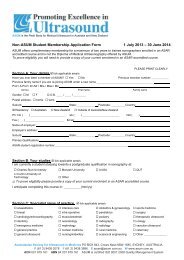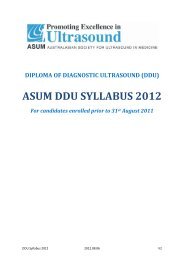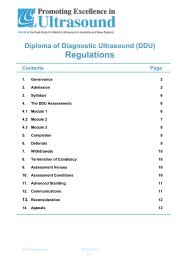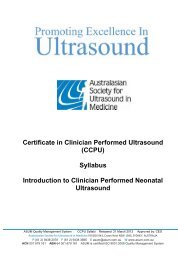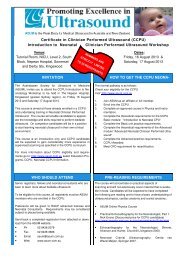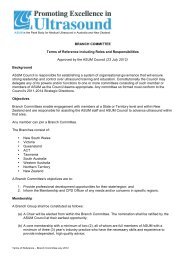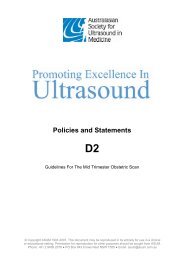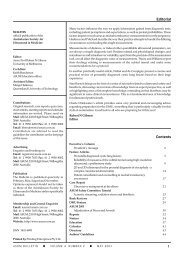Volume 11 Issue 1 (February) - Australasian Society for Ultrasound ...
Volume 11 Issue 1 (February) - Australasian Society for Ultrasound ...
Volume 11 Issue 1 (February) - Australasian Society for Ultrasound ...
Create successful ePaper yourself
Turn your PDF publications into a flip-book with our unique Google optimized e-Paper software.
ASUM <strong>Ultrasound</strong> Bulletin <strong>February</strong> 2008; <strong>11</strong> (1): 39–43<br />
ASM 2007 ABSTRACTS<br />
Abstracts 37th Annual Scientific Meeting <br />
Cairns, 2007: Part 2 – Part 1 published 2007 vol 10 (4)<br />
410 <strong>Ultrasound</strong> of chronic liver disease<br />
Richard B Allan, Flinders Medical Centre, Australia<br />
Objective<br />
To review the use of ultrasound in chronic liver disease.<br />
Chronic liver disease is a common disease and the eighth<br />
leading cause of death in the developed world. Scanning the<br />
liver can be technically difficult due a variety of problems<br />
and the use of small foot print transducers, tissue harmonic<br />
imaging and spatial compounding will all improve image<br />
quality.<br />
<strong>Ultrasound</strong> is relatively insensitive to mild cirrhosis and<br />
there is a poor correlation between the ultrasound appearances<br />
and histological severity. The ultrasound appearances<br />
of cirrhosis are variable but a coarse, heterogeneous echo<br />
pattern is commonly seen. Surface irregularities may be seen<br />
and alteration of the liver architecture due to regenerating<br />
nodules may be present. Appearances may be complicated<br />
by the presence of fatty infiltration. Increased attenuation<br />
and increased echogenicity may be seen if there is an acute<br />
fatty component to liver disease. While fatty liver has variable<br />
appearances these generally fit into easily recognised<br />
patterns.<br />
Common complications of chronic liver disease are<br />
portal hypertension (PHT) and hepatic malignancy. PHT is<br />
a common sequela of chronic liver disease and ultrasound is<br />
used extensively in its diagnosis and monitoring. Of patients,<br />
1–5% will develop HCC and ultrasound is commonly used<br />
as a screening modality.<br />
<strong>Ultrasound</strong> contrast media are used extensively in Europe<br />
and Asia and offer major improvements in the accuracy of<br />
ultrasound. Un<strong>for</strong>tunately, these agents are not available <strong>for</strong><br />
general use in Australia and great opportunities <strong>for</strong> improved<br />
assessment are not being utilised.<br />
4<strong>11</strong> Peyronie’s disease: the long and the short of it<br />
Michelle K Pedretti, Australia<br />
Objective<br />
This presentation will cover the causes, risk factors, signs,<br />
symptoms and treatment variations of Peyronie’s disease.<br />
Sonographic demonstration and appearances will be presented,<br />
although Peyronie’s s disease is generally a clinical<br />
diagnosis.<br />
Cases of Peyronie’s disease have been documented from<br />
as early as 1687. First described by Francois de la Peyronie,<br />
a French surgeon, in 1743. Peyronie’s disease had previously<br />
been classified as a <strong>for</strong>m of sexual incompetence but is now<br />
recognised as a component of erectile dysfunction.<br />
Peyronie’s disease is a benign condition that affects<br />
approximately 1% of the male population. It is most commonly<br />
seen in males between the ages of 45 and 60 years of age. It<br />
can, however, occur in the young and elderly male population.<br />
Thought to have genetic links, its exact nature and etiology<br />
remain uncertain. The condition may spontaneously resolve<br />
in 1–2 years from onset. Surgical intervention is required <strong>for</strong><br />
those in whom the condition does not resolve.<br />
A hard lump, comprised of plaque, in the tunica albuginea<br />
of the penis characterises Peyronie’s disease. The plaque<br />
is thought to originate as local inflammation and develop<br />
into a hardened scar. Plaque development may be on any surface<br />
of the penile shaft, though more commonly is located<br />
on the superior surface of the penis. With penile erection the<br />
plaque causes the penis to bend and can be associated with<br />
pain and distortion.<br />
412 Interventional ultrasound: the basics<br />
Matthew W Andrews, ASUM President, Australia<br />
Objectives<br />
Knowledge of the ultrasound principles and skills underpinning<br />
all ultrasound-guided interventional ultrasound<br />
procedures.<br />
The initial common pathway of all ultrasound-guided<br />
procedures involves the placement of a needle tip into a target<br />
within the body. Once the needle has been placed, a wide<br />
variety of procedures can then be per<strong>for</strong>med.<br />
This talk reviews the current status of the multiple steps<br />
and factors which all contribute to successful needle placement.<br />
Examples of particular procedures will be demonstrated.<br />
The construction of phantoms <strong>for</strong> developing skills<br />
will also be described.<br />
413 Liver Doppler<br />
Richard B Allan, Flinders Medical Centre, Australia<br />
Objective<br />
To review the portal venous system and outline the most<br />
effective methods <strong>for</strong> investigating common abnormalities<br />
with ultrasound.<br />
The liver has complex vascular arrangements and a good<br />
understanding of the anatomy and physiology is essential<br />
when per<strong>for</strong>ming a Doppler ultrasound assessment.<br />
Liver Doppler is a technically challenging examination<br />
due to the difficulties encountered in scanning the diseased<br />
liver and the abnormal flow states often present. Sound<br />
techniques utilising a thorough understanding of the technical<br />
parameters of Doppler ultrasound is necessary to obtain<br />
clinically useful in<strong>for</strong>mation.<br />
The most common pathological processes found in the<br />
portal venous system are portal vein thrombosis (PVT) and<br />
portal hypertension (PHT).<br />
PVT can be accurately diagnosed with ultrasound with a<br />
reported sensitivity of 93% and specificity of 99%.<br />
<strong>Ultrasound</strong> is also used extensively to diagnose PHT<br />
and a number of ultrasound findings have been described<br />
although these have very variable per<strong>for</strong>mances.<br />
While commonly used, both portal vein dilatation and<br />
reversal of flow in the portal vein are relatively poor indicators<br />
of PHT with sensitivities of only 40% and 1–8%<br />
respectively.<br />
The presence of portosystemic collaterals is the most<br />
sensitive indicator of PHT with a sensitivity of 70–83%.<br />
Identification of collaterals is aided by their predictable<br />
positions and clues from flow patterns found in the por-<br />
ASUM <strong>Ultrasound</strong> Bulletin 2008 <strong>February</strong> <strong>11</strong> (1)


